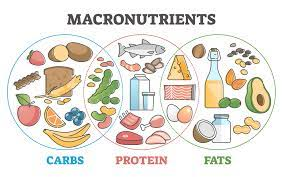Dieting tips and tricks
Eating a healthy diet is one of the most important things you can do to maintain good health. A healthy diet can help prevent chronic diseases such as heart disease, diabetes, and certain cancers. In this blog post, we'll explore the components of a healthy diet, including macronutrients and micronutrients, and provide tips for creating a healthy eating plan that's sustainable and enjoyable.
Macronutrients
Macronutrients are the three main nutrients that our bodies require in large quantities: carbohydrates, proteins, and fats. Each macronutrient has a specific role in the body and provides a different source of energy.
Carbohydrates: Carbohydrates are the primary source of energy for the body. They are broken down into glucose, which is used by the body for fuel. There are two types of carbohydrates: simple and complex. Simple carbohydrates, also known as sugars, are found in foods such as fruit, honey, and candy. Complex carbohydrates, also known as starches, are found in foods such as bread, pasta, and rice.
Proteins: Proteins are essential for building and repairing tissues in the body. They are also used to make enzymes, hormones, and other important molecules. Proteins are made up of amino acids, which are the building blocks of protein. Good sources of protein include meat, fish, eggs, beans, and tofu.
Fats: Fats are important for many bodily functions, including providing energy, insulating and protecting organs, and helping the body absorb certain vitamins. There are three main types of fats: saturated, unsaturated, and trans fats. Saturated fats are found in foods such as butter and meat, and should be consumed in moderation. Unsaturated fats, found in foods such as nuts and avocados, are considered healthier. Trans fats, found in processed foods, should be avoided.
Micronutrients
Micronutrients are the vitamins and minerals that our bodies need in small quantities. They play a critical role in maintaining good health and preventing chronic diseases. Here are some of the most important micronutrients and the foods that are good sources of them:
Vitamin A: Found in foods such as carrots, sweet potatoes, and spinach, vitamin A is important for healthy vision, a strong immune system, and proper growth and development.
Vitamin C: Found in foods such as oranges, bell peppers, and strawberries, vitamin C is important for healthy skin, bones, and blood vessels. It also helps the body absorb iron.
Vitamin D: Found in foods such as fatty fish and egg yolks, vitamin D is important for strong bones and teeth. It also helps the body absorb calcium.
Calcium: Found in foods such as milk, cheese, and leafy greens, calcium is important for strong bones and teeth. It also helps the body maintain a healthy blood pressure.
Iron: Found in foods such as red meat, beans, and spinach, iron is important for healthy blood cells. It also helps the body carry oxygen to the muscles and organs.
TRY: https://b66e15dduek2bw71pevhu41kee.hop.clickbank.net
Creating a Healthy Eating Plan
Creating a healthy eating plan that's sustainable and enjoyable can be a challenge, but it's important for maintaining good health. Here are some tips for creating a healthy eating plan:
1. Focus on whole, minimally processed foods: Choose foods that are as close to their natural state as possible. This means eating plenty of fruits, vegetables, whole grains, and lean proteins.
2. Watch your portion sizes: Even healthy foods can contribute to weight gain if you eat too much of them. Use portion control strategies such as measuring your food or using smaller plates.
3. Limit processed and junk foods: Processed and junk
PERSONALLY RECOMMENDED: https://b66e15dduek2bw71pevhu41kee.hop.clickbank.net


Comments
Post a Comment